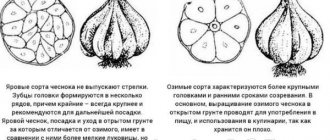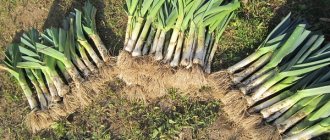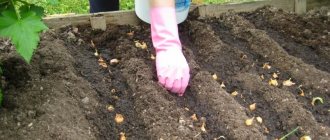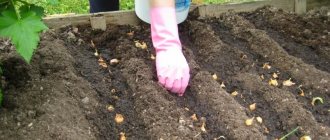Planting tomatoes according to Mittleider gives abundant harvests from a small area and ensures rapid growth of tomatoes. The author of the method is a scientist, an expert in agriculture, with a doctorate in agricultural sciences, American Jacob Mittleider (1918-2006).
His method of growing tomatoes combines hydroponics technology (growing crops on nutrient substrates, without natural soil) with traditional farming. In Russia, the technique has been popular for more than 25 years. Technology has its fans and detractors.
The essence of the Mittleider method
Technology is based on making full use of space, resources and time. Tomatoes are planted densely, providing them with additional nutrition, which makes it possible to increase yield.
Within the technology, there are 2 methods of planting plants.
- Growing vegetables in narrow beds. Used for growing vegetables in open ground.
- Cultivation in box-beds filled with artificial soil mixture. Used in greenhouses and areas with poor soils. The boxes are made of any size, but the depth should be 20-25 cm. At the bottom of the box there is natural soil, the top layer consists of an artificial fertile soil mixture. Boxes for greenhouses are usually made with a bottom, and for open ground only with side walls so that the roots can penetrate into the natural soil.
Who is Jacob Mittleider?
Jacob Mittleider was born in the USA on April 23, 1918, and was an agricultural expert and Doctor of Agricultural Sciences. Worked in:
- growing seedlings on an industrial scale, working in a nursery located in Southern California;
- creating your own quick way to grow vegetable plants;
- development of the most suitable mineral nutrition for vegetable crops;
- breeding new varieties of carnations (5 of which received copyright);
- creating commercial cultivation methods, packaging and airlifting live plants for sale in various areas;
- the invention and creation of a special Mittleider greenhouse.
Advantages and disadvantages of the method
Like any other method, planting tomatoes according to Mitlider has its pros and cons.
Advantages of planting using the 1st method in narrow beds:
- Increased yields. Tomatoes are supplied with additional nutrients, as in hydroponics. The difference between the method is that the roots have access to the minerals found in the ground.
- Rational use of space, time and labor resources. Material costs for growing tomatoes are kept to a minimum, the area of the beds is small, and the time and effort required to cultivate them is significantly reduced.
- Balanced plant nutrition. Mitlider has developed balanced fertilizers that include all the necessary elements for plants. The mixtures were formulated based on 35 years of testing and experimentation.
- Protection from cold, wind and snow. In emergency situations, narrow beds can be easily covered by constructing film shelters or mini-greenhouses.
- Economical use of water is especially important in dry years. Water is supplied only to the root system. The irrigation area is smaller than in classic beds.
Advantages of box beds:
- Productivity does not depend on the quality of local soils; boxes can be installed on any site.
- Requires a small area.
- The method provides balanced nutrition of tomatoes, good drainage and aeration of the roots.
- The soil in shallow boxes quickly warms up in the sun in the spring, lengthening the growing season.
- The soil in the boxes is loose and moist, which allows the roots of the tomatoes, after passing through a layer of artificial soil mixture, to reach the natural soil.
Disadvantages of the method:
- Wetlands, sandy areas and areas on slopes are not suitable for using narrow bed technology.
- In shaded gardens, the yield is reduced by 3-4 times.
- Forming beds is more difficult than with the usual method of growing tomatoes.
- It is difficult for novice amateur vegetable growers to correctly formulate fertilizers, since they contain many components.
Fundamentals of vegetable growing according to Mittlider
Farming is not easy work. To get a good harvest, you need to “plow” tirelessly for 8-9 months a year. To make the work of gardeners and gardeners easier, many new technologies have been developed. An alternative method of cultivating a vegetable garden is offered by American vegetable grower, Doctor of Agricultural Sciences Jacob R. Mittlider.
Autumn harvest of vegetables
My acquaintance with his method began with an article in an old magazine, I became interested. I read more materials and decided to experiment on my site. I studied what Mittlider and T. Ugarova wrote, who, on the pages of her book “Family Vegetable Growing in Narrow Beds,” spoke about Mittlider’s method, adapted to Russian realities.
The method is positioned as an effective land cultivation technology. It allows you to grow enough vegetables on 1.5-2 acres to last a family of four to five people for a year. At the same time, the quality of the soil is not of decisive importance: vegetables can be grown on waste land, completely overgrown with weeds, and on “poor” infertile soils.
What varieties of tomatoes can be grown according to Mittleider
Planting tomatoes according to Mittleider is applicable for growing determinate (with limited growth) and indeterminate (tall) varieties.
It is traditionally believed that in temperate climates, low-growing varieties can be grown in open and closed ground, and tall varieties can only be grown in greenhouses.
However, breeders have developed many modern early-ripening indeterminate varieties that grow well in open beds. Therefore, both methods 1 and 2 are suitable for growing low-growing and tall bushes.
Gardeners: pros and cons
– In three years I haven’t seen any particular advantages yet. Mitlider recommends keeping the window open all the time, but we also have frosts in June, and sometimes in July the temperature at night drops to almost 10 degrees, so the window must be opened and closed all the time. And since it is located at a height of almost 3 meters, you have to keep a stepladder ready.
Formation of beds
Site preparation includes the following steps.
- Before starting to form the beds, the area is leveled, hummocks and debris are removed.
- Dolomite flour is added to acidic soils. Gypsum is added to alkaline soil.
- Provide good water drainage. To do this, remove the top layer of soil, put 20-30 cm of bark and sawdust, then return the fertile layer to its place. In lowlands, the ground is raised by 20-25 cm.
- The rows are arranged strictly from north to south.
- The beds are formed at the same level as the row spacing, neither higher nor lower.
Structure of narrow ridges
According to Mitlider, narrow beds are 45 cm wide and 9 m long (the length can be changed). On the sides of the bed along the long side, earthen edges 10 cm high and wide are poured. The width of the inner part of the bed between the edges should be 30-35 cm. It is also advisable to make edges at the ends. The surface inside is carefully leveled.
With this formation, water does not flow into the rows and is completely used.
The distance between the beds is 105 cm. This is necessary for good illumination of the plants and sufficient space for their growth. In small areas, row spacing can be reduced to 75 cm when planting varieties with compact bushes.
Personal experience
As part of the experiment, I made several narrow beds in my garden, allocating a small area for them that is not plowed. The day before sowing, I prepared four beds measuring 0.45 x 5 m and arranged them lengthwise from north to south. I did the same as usual: I marked the selected area using pegs and a cord, dug up narrow strips, leaving the row spacing untouched. I leveled the ground and raised sides about 8-10 cm high along the edges of the bed.
In these beds along the sides, I sowed carrots, garlic, and lettuce in two parallel rows. Combined radishes and lettuce in one bed. The passage between the beds turned out to be 85 cm. Planting care is usual - watering, weeding at the initial stage. The plants grew quickly and there were no weeds. I simply weeded the rows and dug up perennial weeds, but in two years I couldn’t completely get rid of the weeds between the beds.
The technology for growing vegetables according to Mittlider is controversial, but, in my opinion, worthy of attention: I liked weeding narrow beds, it was easy to reach any weed, and it was convenient to walk between the rows with a hose. You could say I didn’t thin out the carrots, I just started pulling them for food in mid-June. For lettuce and radishes, I applied only pre-sowing fertilizer, and for carrots and garlic - 2 times during the summer. I removed the lettuce and radishes at the beginning of June, and planted seedlings of annual flowers in this bed. The carrots and garlic were a success; there was enough for ourselves, relatives and neighbors.
Carrot harvest
The idea of box beds is also tempting. I have an abandoned clearing in my fence, with a continuous carpet of wheatgrass growing on it. I made two frames from boards and installed them there. I made up artificial soil from sawdust, tree bark (8 buckets each) and sand (4 buckets). She mixed everything thoroughly and scattered it over the beds. I just didn’t dare plant it in completely artificial soil and sprinkled a 3-5 cm layer of garden soil on top.
I planted greenery in box-beds and was pleased. And the place has been improved, and there is greenery all summer, and there is no need to weed the weeds.
This year I plan to grow seedlings in a greenhouse using the Mittlider method as an experiment, filling the seedling boxes with artificial soil. Maybe someone has experience growing seedlings using this technology? I would like to know your opinion.
Fertilizer application according to the Mittleider method
The scientist has developed 2 compositions for fertilizing beds and feeding crops during the growing season.
- Mixture No. 1 is used as a pre-planting fertilizer. Components of the first mixture: nitrophoska (450 g), lime, chalk or dolomite (900 g), borax (15 g).
- Mixture No. 2 is used before planting and for regular fertilizing of crops.
There are 2 variants of this fertilizer.
- Option 1. Urea or urea (1 kg), ammophos (600 g), calcium sulfate or chloride (1 kg), magnesium sulfate or bitter salt (450 g), lime or dolomite (400 g), boron and molybdenum (10 each G).
- Option 2. Ammonium nitrate (675g), calcium sulfate or chloride, lime and magnesium (450 g each), nitrophoska (2.7 kg), borax and molybdenum (10 g each).
Before planting the plants, the bed is fertilized with one of the mixtures, depending on the type of soil.
After applying fertilizers, the surface is dug up to a depth of 15-20 cm.
Boxes-ridges, before planting tomatoes in them, are filled with sand, sawdust, perlite, sphagnum moss, pine bark or other available materials. Use 3-4 components at a time. Add 2/3 of mixture No. 1 and 1/3 of mixture No. 2 to the box. Water the contents generously and mix well. Then they are leveled.
Growing vegetables in box beds
The second version of the Mittlider method allows you to grow vegetables on artificial soils in box-beds. Frames without a bottom of any size are made from materials at hand (boards, slate, logs). Typically, the width of the box is 45, 120, 150 cm, the recommended depth is 20 cm. The frames are installed in the designated area and filled with artificial soil.
Box beds
The mixture is made up of two or three components available at hand: sawdust from deciduous trees, sphagnum moss, perlite, sand, polystyrene foam, straw, nut shells, sunflower husks. The percentage is as follows: 20% sand, 40% of other components. The soil in the boxes is not changed; the same one is used from year to year. Natural soil is not used to fill the boxes.
Before sowing, the beds are fertilized. 4.5 kg of mixture No. 1 and 2.5 kg of mixture No. 2 are added to a box measuring 9x1x0.2 m, distributed evenly over the entire area and watered. Then the soil mixture is mixed, the surface is leveled and watered again. Grooves for planting plants are made across the box. The distance between the grooves depends on the type of plant.
The seeds are scattered along the furrows, planted and watered. Immediately after planting, apply fertilizer from mixture No. 2 - 600 g per 9-meter bed. Then the plants are fed every 10 days. Fertilizers can be applied in two ways:
- Dry . Fertilizer is scattered around the plants if the distance between the rows is 30-50 cm. If the distance is 15-17 cm, it is scattered between the rows.
- Solution . Dilute the required amount of fertilizer in water and water the bed. For 600 g of mixture take 66 liters of water.
Boxes-beds on a slope
Sowing tomato seeds
- For sowing, choose large, strong seeds without black spots. Planting is carried out in boxes filled to the brim with loose nutritious soil.
- Add 2 tablespoons of lime and 15 g of potassium fertilizer and phosphate to the soil.
- Water the soil carefully to prevent a crust from forming.
- The seeds are planted in rows at least 5-7 cm apart at a depth of 1-1.5 cm, carefully sprinkled with soil and watered again.
- The box is covered with burlap or gauze to retain heat and moisture.
- As soon as the first sprout hatches, the burlap is removed and the container is moved to a sunny place.
- Before planting in a permanent place, the seedlings are watered from a watering can with a weak solution of fertilizer No. 2 (25 g of fertilizer is diluted in 10 liters of water).
When planting seeds in warm climates in open ground, make a shallow furrow along one of the sides, leaving the middle of the bed free. Plant the seeds individually at a distance of 20 cm from each other.
Basic rules of my approach
There are several approaches to growing tomatoes. Let's divide them into two main ones: the technology of growing tomatoes in a greenhouse and growing tomatoes in open ground.
We will consider both of these approaches, but let’s first agree that we will be talking about natural farming in small greenhouses and our own plots.
First, let's look at the main goals that we will strive to achieve by growing tomatoes on our plot.
- The first thing that should concern us is the opportunity to grow a tasty, healthy tomato, which in many respects is superior in quality to the tomatoes sold in the store.
- The second is to grow tomatoes not of technical ripeness, but of table ripeness.
- The third thing is to stretch out the fruiting period as long as possible.
- And lastly, but for many the main thing is to get a large harvest per tomato bush. Now slowly from the very beginning.
Of course, seeds
It all starts with tomato seeds. And it is necessary to choose them, taking into account exactly the goals that we have set for ourselves. This means that we definitely won’t get by with just one variety. The best-tasting tomatoes come from pure varieties, called heirloom varieties. To grow tomatoes in open ground, you need early, most likely determinate, varieties that are resistant to late blight, the main enemy of open ground.
I would suggest choosing 5-6 varieties for open ground and 3-4 for the greenhouse, if there is only one.
We’ve figured out a little about seeds, carefully read reviews, look for experienced gardeners in your area and experiment more yourself, create your own seed fund. Remember that the germination capacity of tomatoes lasts up to 15 years.
Seedling
The second secret to success is good tomato seedlings. The thing is that tomato seedlings, unlike pepper seedlings, must achieve their optimal growth precisely by the time they are planted in a permanent place, this is the moment the first flower cluster budding. Both overgrowth and underdevelopment of seedlings do not have the best effect on the harvest. Based on this, seedlings for open ground should be started to be grown later than seedlings for planting in a greenhouse. And approximate dates can only be arrived at through experience. But for the Moscow region this is from March 5-10 for greenhouses and from March 20-25 for open ground, while making adjustments for the characteristics of each variety. See detailed technology for growing seedlings here.
Bush care
The third secret is caring for tomato bushes.
And here, if in a greenhouse you will most likely have to deal with the heat, creating conditions for good ventilation, then in the open ground, on the contrary, create conditions for preserving heat (protection from northern winds, dark mulching of the soil, ensuring good heating, etc.).
There are also differences in formation. If indeterminate varieties are mainly grown in a greenhouse, then they are formed into 1-2 stems. In open ground, determinate ones are more often used, which form 3-4 stems or do not shoot at all, leaving all the shoots. There is an article about formation with a visual illustration.
Priming
And of course, the main condition for good growth of tomatoes is the creation of suitable soil.
If we take it as a basis to abandon mineral fertilizers, then the main soil fertility should be high-quality compost, the soil should be loose and deeply structured, this is created by growing green manure in the autumn.
Another mandatory condition regarding the soil is the mandatory mulching of the surface.
Watering
And lastly, this is the correct watering of tomatoes.
If in a greenhouse we can control watering and draw up a schedule, then in open ground nature often interferes with our plans with its rains.
Here it is necessary to take into account the amount of precipitation, place an empty wide container, for example a basin, measure its diameter, and you can always measure how much water a particular rain shed, accordingly reduce or reschedule watering the tomatoes.
Planting seedlings
Tomato seedlings are planted in a permanent place when they grow 15-30 cm in height (depending on the variety). The sprouts are placed along one side in rows at a distance of 20 cm from each other. The bushes are planted in holes with a large lump of earth, deepening the plants so that at least half of the stem remains on the surface.
Before planting in a permanent place, the sprouts are watered abundantly. For better survival in a new place, seedlings are watered with nitrogen fertilizer dissolved in water. To prevent tall plants from shading small ones, they are placed on the north side of the bed, giving small plants more light.
In the video, the gardener explains the principle by which tomatoes planted using the Mittleider method grow in a greenhouse.
What other greenhouse designs are there?
| droplet Does not require any maintenance in winter, since snow does not linger on the steep slopes of the roof. In addition, such a greenhouse also looks original. |
| House Thanks to the gable roof in such a greenhouse, even tall plants can be planted along the walls and the frame is not afraid of heavy snowfalls. |
| Snowflake Its retractable roof protects plants from the heat and allows rainwater to enter. The roof can be opened either manually or installed automatically, which does not require electricity. |
| Greenhouse "butterfly" Convenient for growing cucumbers and melons. Lifting side covers provide easy access to plants, the design can withstand snow and can be moved from place to place. |
Stages of tomato care
- Watering should be regular so that the soil in the garden bed is constantly moist.
- Plants are watered only at the roots, since many weeds grow when irrigated by sprinkling.
- The garter is carried out when the bushes have reached a height of 40 cm.
2 fishing lines are stretched along the sides of the bed, to which each plant is tied with an individual cord in a checkerboard pattern. The first tomato to the right line, the next to the left line. This way the bushes will be better illuminated. The lower end of the cord is tied to the stem near the ground with a knot so that a free loop remains.
As the stem grows, it may thicken; it is important that the node does not interfere with its growth. The bush is wrapped around a rope, and when the plant reaches the wire, the top is pinched.
- To prevent plants from shading each other, some of the leaves are torn off.
First of all, get rid of the lower leaves and part of the side branches. In tall varieties, shoots are removed, forming bushes with 1 stem. In low-growing varieties, shoots are usually left behind.
- The use of pesticides and nitrates is completely abandoned.
Regular watering, proper nutrition and the natural process of photosynthesis allow tomatoes to independently regulate life processes in the ecosystem.
- Seedlings are fed 6-8 times per season with fertilizer No. 2 diluted in water.
- When tomatoes are affected by diseases, remove diseased leaves and fruits to prevent the spread of infection.
To prevent fungal diseases, with the onset of cold nights, treatment is carried out with foundationazole, ridomil or Bordeaux mixture. Treatment cannot be carried out during the fruiting period.
How to choose mineral fertilizers for garden beds?
Judging by the reviews of experienced greenhouse owners, they are very, very pleased with Mitlider’s technique, although at first many are not in the habit of slowly selecting mineral fertilizers. So far, many have settled on the following formulas: “Calcium nitrate N:P:K=17:0:0” and “Ammophos (N:P=12%:52%)”. Everything is purchased in the fall, and sometimes for more than one year - so that later you don’t have to look for anything and buy more expensive ones.
Fertilizers must be applied to the Mittleider beds in a “pulsating” way – i.e. fractionally, which provides plants with a high degree of absorption, and, therefore, high yield in the end. The dry fertilizer mixtures themselves are poured in a strip exactly in the middle of the narrow ridges - between two rows of plants. They need to be dissolved by watering. This is a really good method, because with it the roots of the plants are not burned by the concentrates.
Subscribe to RSS feed
Subscribe RSS
Subscribe to gardener's blog updates via RSS or e-mail:
03SepAuthor:
Gardener
Today there are a huge number of ways to increase the yield of vegetable crops. But among their huge variety, one of the most effective and worthy of attention should be highlighted - the method of Jacob Mittlider, an international expert in the field of agriculture. Its use ensures high and stable vegetable yields under any climatic and soil conditions. If you follow the instructions, you are guaranteed to obtain a potato harvest of up to 800 kilograms per hundred square meters. To provide vegetable crops (without potatoes) for one person, according to Mittlider, 0.4 acres is enough. At the same time, he uses standard mixtures of mineral fertilizers, 36 kg of lime and 46 kg of mineral fertilizers per two hundred square meters per season, believing that strict dosage does not cause any harm to human health; he leaves organics a secondary role. Plants are grown in narrow beds with meter-long paths between them, which ensures ideal illumination. Much attention is paid to disinfection of soil and tools. It is forbidden to even handle plants with dirty hands! An opponent of sprinkler irrigation, he recommends “soft watering”: a cloth is wrapped around the tip of the hose in three layers, the soil is soaked to 7.5 cm, watered daily, in cold weather - three times a week.











